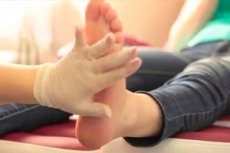Medical expert of the article
New publications
Foot massage for heel spurs: basic techniques
Last reviewed: 03.07.2025

All iLive content is medically reviewed or fact checked to ensure as much factual accuracy as possible.
We have strict sourcing guidelines and only link to reputable media sites, academic research institutions and, whenever possible, medically peer reviewed studies. Note that the numbers in parentheses ([1], [2], etc.) are clickable links to these studies.
If you feel that any of our content is inaccurate, out-of-date, or otherwise questionable, please select it and press Ctrl + Enter.

When a bone growth appears on the heel bone of the foot – due to problems with the plantar fascia (plantar fasciitis) – orthopedists recommend doing a heel spur massage, as well as regularly doing exercises for heel spurs.
Massage for heel spurs at home
Those who have this problem are interested in whether it is possible to do and how to do massage for heel spurs?
Experts say that massage can and should be done to activate local blood supply and trophism of all groups of plantar muscles of the foot, as well as to increase the elasticity of their connective tissue sheaths (fascia) and tendons that attach muscle fibers to the joints. For many patients with heel spurs, such massage helps not only reduce heel pain, but also improve the mobility of the foot and ankle joint when moving. But it must be done correctly.
Foot massage for heel spurs should involve all muscle groups that not only support the arch of the foot, but also provide flexion and extension of the toes. These are the plantar medial muscles (the largest square and smaller ones) attached in the area of the calcaneal tubercle; muscles located or passing along the edge of the sole (with attachment to the bones in the areas of articulation of the heads of the metatarsal bones with the bones of the proximal phalanges of the toes).
The most convenient way to do this massage is to sit on the floor or any hard surface, bend one leg at the knee and move it closer to the inner thigh of the other leg (which remains straight). There are several simple foot massage techniques, in particular:
- rubbing the sole of the foot with the fingertips joined together (grasping the instep with the thumbs), making circular movements, which should start from the toes and end in the area of the heel spur;
- transverse rubbing of the sole with the edge of the palm;
- pressing and rotating rubbing of the arch of the foot with a fist (with the protruding joints of the fingers, forming a kind of ridge when squeezing the hand);
- the same rubbing of the convex part of the sole (pad);
It is recommended to massage the heels for heel spurs:
- grasping the heel with the hand and performing pressing and rotating rubbing with the fingers;
- rubbing the heel with the edge of the big toe;
- imitating an attempt to move the heel, tightly grasping it with the entire hand and squeezing the fingers, moving it forward and backward and right and left).
The massaging movements should cover the area of the ankle joint, and also – to enhance the effect – the calf muscles: from the ankle up to the knee.
Therapeutic exercises for heel spurs
Any physical exercise for heel spurs (except jumping and squats with weights) will be beneficial due to the acceleration of blood circulation, and, therefore, the improvement of oxygen supply to all tissues. Even walking barefoot on sand or pebbles can be included in therapeutic exercises for heel spurs...
So, what exercises should you do for heel spurs?
Exercises for the foot with heel spurs are practically the same as for flat feet, and target the same muscles as massage. This includes alternate walking on toes, with the entire foot and with the heel resting (for several minutes, two or three times a day); and rolling a small ball or any cylindrical object (for example, a filled bottle of small diameter) back and forth with the arch of the foot.
The optimal set of exercises for heel spurs includes simple exercises performed standing or sitting.
In a standing position you need to do:
- regular squats, but without lifting your heels off the floor;
- forward bends with your hands resting on a wall, from which you need to move a short distance (your heels also do not come off the floor);
- alternately raising and lowering on the toes to a small elevation - with an elastically tense sagging of the heel of the foot in the air.
Exercises for the foot with heel spurs in a sitting position (on a chair):
- place your feet on the floor and, resting on your heels, lift them up, tensing your calf muscles;
- the same, but raise your feet up – with support on your toes;
- place your feet on the floor and press your toes hard, resting on your heels;
- the same, but raise your fingers up, without lifting the pads off the floor;
And while sitting on the floor, you need to straighten your legs and pull your feet towards you, that is, towards your shins, hold this position for a few seconds, and then in the opposite direction - away from you, stretching out the “ballerina’s rise”.

